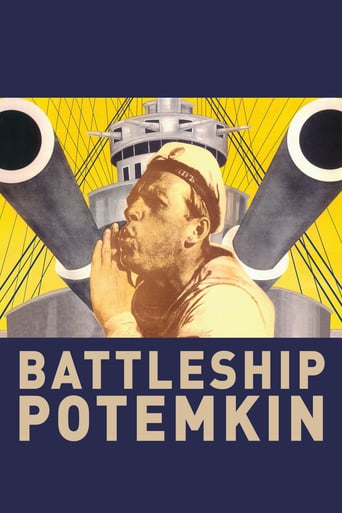

What a beautiful movie!
... View MoreThanks for the memories!
... View MoreThe film never slows down or bores, plunging from one harrowing sequence to the next.
... View More.Like the great film, it's made with a great deal of visible affection both in front of and behind the camera.
... View MoreAll true cinephiles know about "Potemkin" and how it revolutionized cinematic techniques in editing. We all know about that insane, constantly referenced/parodied Odessa steps sequence, but do we really know WHY "Potemkin" is a GREAT movie? Not just an influential or famous movie, but an actually GREAT movie?Well, in my opinion, the reason that "Potemkin" is so great is its ability to manipulate emotions and have relentless emotional energy and thrills. In its slim 70 minute runtime, more emotional intensity has struck the audience than in most 2 hour action thrillers. This film may be communist propaganda, but its also damn good communist propaganda. I may not agree with the film's political intent, but while I'm watching it I sure do! Using the power of film and visuals, Eisenstein works as a master manipulator, pulling at every string in your body, a surging sea of pain and sorrow exploding across his forever influential screen. Who could ever forget those haunting images? The child being trampled on! The baby carriage falling! The old woman with her shot out! Blood everywhere! Tons of extras falling down these mammoth stairs. Its more thrilling than any horror film you've ever seen, and its damned brilliant if you ask me!
... View MoreThat, of course, is far from a fresh observation but it's true. Sergei Eisenstein's Battleship Potemkin tells the real life story of the 1905 mutiny on the Potemkin in the Russo-Japanese War. When the crew of the Potemkin are fed borscht made from rotten meat most opt to eat bread and butter instead. When the officers of the ship hear of this, they become outraged and they believe the enlisted men of the ship to be spoiled. Chief Officer Ippolit Giliarovsky (Grigori Aleksandrov) orders the men the be executed. A revolutionary sailor named Grigory Vakulinchuk (Aleksandr Antonov) inspires a mutiny and the oppressive officers are thrown overboard. The mutiny is successful but Vakulinchuk is killed by Giliarovsky. The sailors mourn their fallen hero and deliver him to the port at Odessa. When the Odessa residents learn of what has happened they protest but are brutally suppressed by the Tsarist guards. In response a revolution goes underway. The film is done very well and has since come to be regard as one of Russia's best films. Not to mention the commonly used soundtrack by Dmitri Shostakovich is brilliant and perfectly fitting. The film is most famous for the "Odessa steps" sequence, so much so that the stairs on which the sequence was filmed has come to be known at the "Potemkin stairs." It is important to note that no such event took place at the Potemkin stairs but that doesn't make the sequence any less groundbreaking. It should also be said that the film is brutally violent, even by today's standards. Overall, Battleship Potemkin is highly recommended.
... View MoreIt's sixty-six minutes of perhaps the most arresting imagery in movie history, also one of the most dynamic. Every shot includes movement of some kind, whether people, smoke, guns, or the prow of history overtaking us. There's no scene of focal conversation, let alone silent talk. Thus politics of revolt remain largely unregistered. Instead the symbolism of rotten meat force-fed to sailors sums up crumbling Tsarist rule. The revolt is told in compelling movement, crowds rushing to and fro, Tsarist forces ahead or behind. One after another, the human wave cascades, with hardly time to breathe. Surely, the Odessa Steps is one of the most memorable in all moviedom; at the same time, a common humanity is deepened-- the dead baby, the shattered eyeglasses. Yes, the 1905 revolt failed. But seed was planted taking down Tsarist rule but ten years later. No need to go on—the film's brilliance is there for all to see, and remains so though not a word is spoken. It's Eisenstein's masterpiece, an enduring one-of-a-kind.
... View MoreBattleship Potemkin is a 1925 silent drama film directed by Sergei Eisenstein and is often considered one of the greatest films of all time for its revolutionary camera work and incredible montage techniques, impressive action sequences and compelling plot of comradeship. The story is told through five acts which goes from an uprising on the Potemkin against the barbaric ship captain and senior officers all the way to Odessa to begin an uprising and leading to one of the most important and at the time shocking scenes in cinematic history- the infamous Odessa steps massacre, where we really see how Eisenstein didn't shy away from graphic and near-disturbing imagery The plot has a distinct and recognisable narrative which is now the backbone and basis of film today, again showing how significant and of great importance it is, with a distinct first, second and third act, all the while telling a phenomenal tale and delivering a hugely satisfying, tense and fantastic ending. The film proves itself over and over again as the story evolves and constantly betters itself throughout, its powerful and at times brutal imagery really pushes and signifies the message. Battleship Potemkin is a shining example of early Soviet film and the most significant motion picture of the silent era, still after all these years remaining one of the all time greats, the film never fails to deliver on its hard-hitting emotional impact, graphic violence, alliance-themed story and ground-breaking, hugely influential film making from a mastermind of the era. Battleship Potemkin is a prime example of a perfect film, with the only nit-picking flaws being in an overly long middle act, with a leads to a temperamental delay on forwarding the plot. 10/10.
... View More